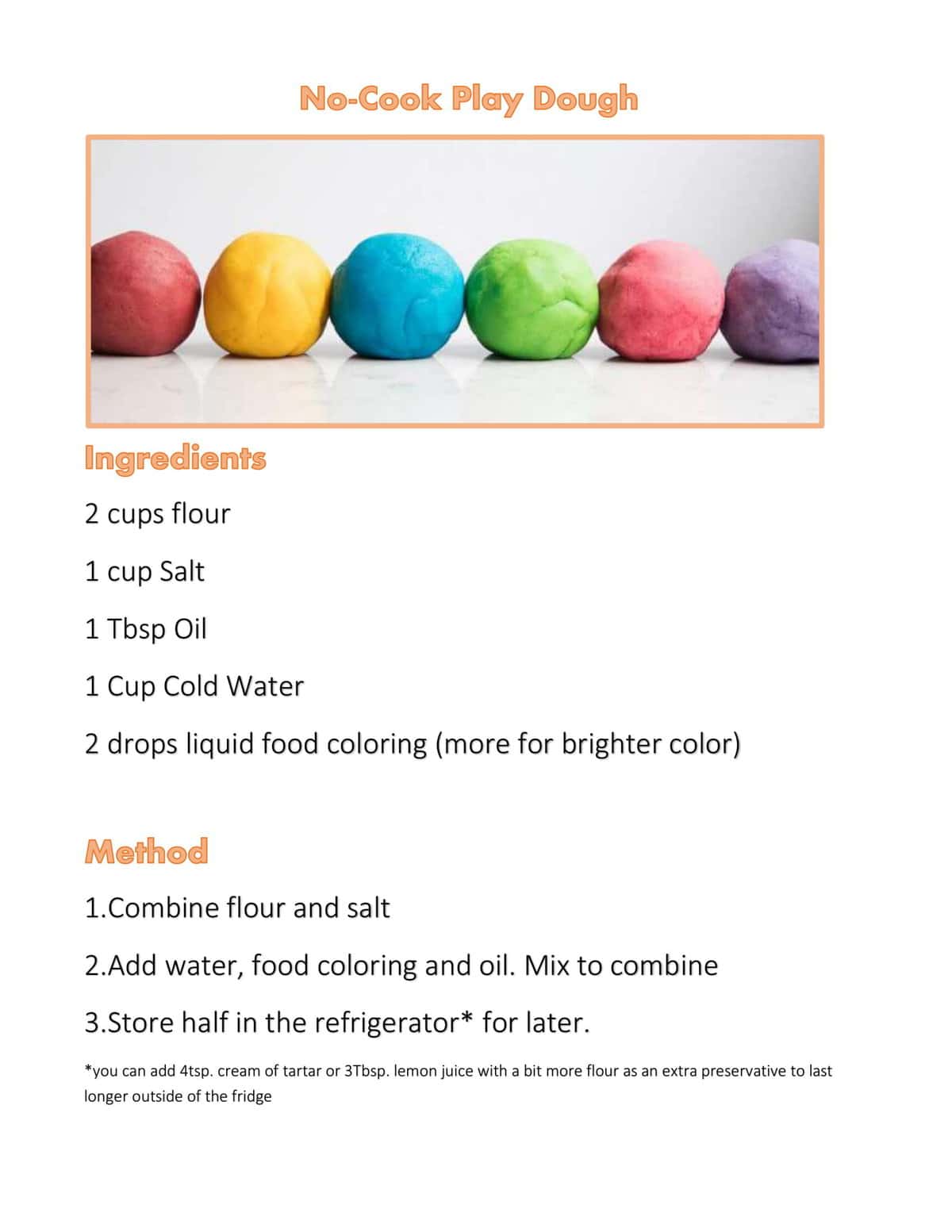Wholesome No-Salt Play Dough Recipes for Endless Fun
Hey there, amazing parents and creative guardians! Is your kitchen your castle and your little one the charming prince or princess within? It’s time to blend some magical fun into your child’s playtime with our easy-peasy no-salt play dough recipes! Not only are these concoctions perfect for tiny hands to squish, roll, and shape, but they’re also made without salt—a win for those watching out for sodium intake! Get ready to create an entertainment kingdom where imagination knows no bounds.
Understanding the Benefits of No-Salt Play Dough
You might wonder, “Why no salt?” While salt does help preserve play dough, it can be a bit harsh on delicate skin, and it’s a no-go for kiddos who tend to give their creations a taste test. With no-salt dough, you’re crafting a safer environment for your child’s adventures in kneading and molding. Plus, it’s super easy to prepare with common household ingredients!
What You’ll Need for Your Homemade Play Dough
Gearing up for a play dough extravaganza doesn’t require a treasure trove of supplies. Here’s a simple list to get you started:
- Flour – the base of your doughy creation
- Cream of tartar – for a smooth and elastic texture
- Vegetable oil – a pinch for that perfect consistency
- Water – vital for binding everything together
- Food coloring – to jazz up your palette
- Natural flavor extracts or essential oils – because who doesn’t love a sensory adventure?
Let’s Get Mixing: Your Step-by-Step Guide
Ready, set, mix! Follow these simple steps to create your very own batch of sparkling, no-salt play dough:
- Gather all your ingredients and tools so everything’s within arm’s reach.
- In a medium-sized pot, mix together 1 cup of flour and 2 tablespoons of cream of tartar.
- Add in 1 tablespoon of oil and 1 cup of water to the dry mixture.
- Choose your food coloring and add a few drops to the pot, stirring until you get your desired hue.
- Stir in some natural flavor extract or a couple of drops of essential oil for a sniff-terrific experience.
- Place the pot over medium heat and keep stirring. As the mixture thickens, it’ll start resembling dough.
- Once the dough forms and starts pulling away from the sides, remove it from the heat.
- Allow the dough to cool slightly before kneading it on a flour-dusted surface.
- Knead your heart out until it’s just the right texture—smooth, pliable, and oh-so-squishy!
And voila! You’ve just made your very own no-salt play dough ready to be poked, prodded, and pressed into whatever your kiddo’s heart desires! Storage is a cinch, too—just pop it into an airtight container, and it’ll stay fresh for a good amount of play sessions.
Fun Beyond the Dough: Creative Play Ideas
Magic happens when play dough meets imagination. Encourage your little creators to:
- Roll out the dough and use cookie cutters for fun shapes
- Build a colorful dough garden with pretend flowers and insects
- Fashion a fleet of dough cars and trucks for an epic race
- Create fantasy creatures and have storytelling sessions
- Imprint patterns using stamps, textured materials or natural objects like leaves and shells
Diving into play dough activities not only spikes creativity but also hones fine motor skills and hand-eye coordination. Plus, it’s an excellent bonding opportunity for family fun.
Before I leave you to your dough-tastic adventure, let’s talk safety. Always supervise playtime, especially with younger children who may still explore the world mouth-first. And remember, no-salt play dough may be better for sensitive skin and those munchy little moments, but it’s not intended for snacking!
Keep an eye out for our comprehensive guide on creative ways to maximize play dough fun while ensuring the safety and joy of your cherished little ones. We’re excited to see how you and your child shape your playtime with these hassle-free, no-salt play dough recipes—get ready to roll out a colorful canvas of wonder!
Join us in the next section where we’ll share even more tips and tricks to keep the amusement rolling with homemade play dough accessories and the secrets behind preserving your no-salt creations for lasting enjoyment. The fun never stops when you’re crafting with love!

Five Things Parents Should Know Before Preparing No-Salt Play Dough
Before diving into the whimsical world of no-salt play dough, here are five essential tips to ensure a smooth preparation process:
- Select Non-Toxic Ingredients: Since children may end up tasting their doughy masterpieces on impulse, it’s crucial to select food-grade, non-toxic ingredients for your play dough. This ensures your little ones can play without any health risks.
- Quality Over Quantity: While it may be tempting to go all out with food coloring and scents, a little goes a long way. Use just a few drops of food coloring to achieve bright colors and a small amount of natural flavor extracts or essential oils for a pleasant scent. This prevents the dough from becoming too sticky and maintains a safe sensory experience.
- Temperature Control: When mixing and heating your ingredients, it’s important to do so on medium heat and keep a vigilant eye. Overheating the mixture can lead to a hard, crumbly texture, spoiling the fun.
- Allergy Awareness: Be mindful of any allergies your child or their playmates may have. If someone has a wheat allergy or gluten intolerance, consider using gluten-free flour options to create an inclusive play environment.
- Preparation and Clean-Up: Prepare a designated area for play dough fun where you can easily clean up after. Non-stick surfaces, wax paper or plastic tablecloths can help with the cleanup process. Teaching your children to play in a contained space also instills good habits for creative activities.
Alongside these pointers, here’s a little extra advice: Embrace the mess! It’s all part of the creative process. And who knows? Your child might just sculpt the next masterpiece, or you might bond over a playful mess that turns into incredible memories.
Keeping Your No-Salt Play Dough Fresh
To ensure the longevity of your homemade play dough, follow these steps:
- Store it in an airtight container or a sealed plastic bag.
- Keep it in a cool, dry place away from direct sunlight.
- If the dough starts to dry out, you can knead in a few drops of water to bring back its pliability.
- If you notice spots or an unusual odor, it’s time to discard the dough and whip up a fresh batch—safety first!
By maintaining your play dough properly, you’ll ensure that every play session is just as exciting as the first. This boosts not just the shelf life of your dough but also the joy it brings to your little ones’ playtime.
Creating no-salt play dough at home is more than just a craft—it’s a doorway to learning, a means for sensory exploration, and a canvas for creativity. With these tips, recipes, and your eagerness to dive into hands-on fun, you’re all set to offer your children a playful experience that’s as educational as it is entertaining. So, roll up your sleeves and let the doughy delights begin!
In our upcoming segment, we’ll cover even more insights, such as “10 Creative Educational Games with Play Dough” to further engage your child’s mind and motor skills. The possibilities with play dough are as limitless as the imagination—stay tuned to explore them all!
See more great Things to Do with Kids in New Zealand here. For more information see here
Disclaimer
The articles available via our website provide general information only and we strongly urge readers to exercise caution and conduct their own thorough research and fact-checking. The information presented should not be taken as absolute truth, and, to the maximum extent permitted by law, we will not be held liable for any inaccuracies or errors in the content. It is essential for individuals to independently verify and validate the information before making any decisions or taking any actions based on the articles.




